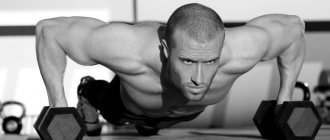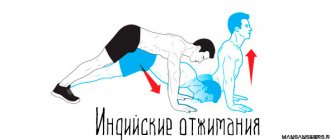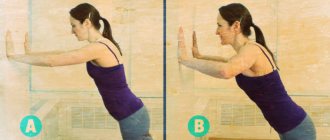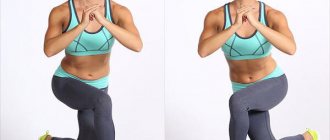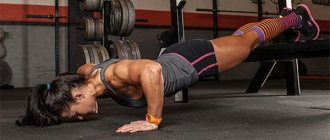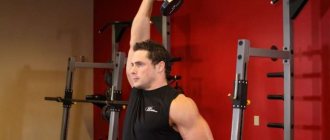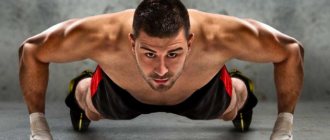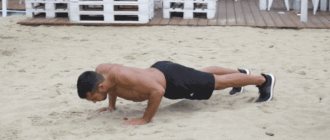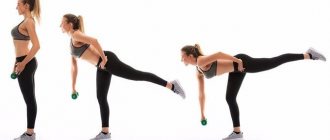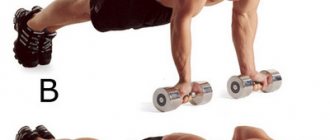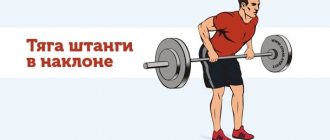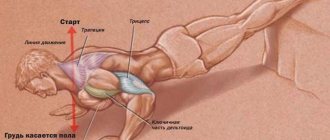Benefits of triceps push-ups
- This is an excellent basic exercise that involves almost all the muscles of the shoulder girdle.
- Allows you to work with your own weight, without special equipment and simulators. You can do it at home, doing push-ups from a chair or sofa.
- Helps stretch the fibers of the pectoral muscles, opening the chest, improving posture.
- Strengthens the ligamentous apparatus of the shoulder girdle, allowing the muscles to subsequently receive serious load when working with weights.
- Increases overall endurance.
- Helps speed up metabolism.
The best exercise for the chest is the head down press[edit | edit code]
The incline bench press is just as popular in gyms as the classic flat bench press. The bench press is often neglected, and, as a study conducted at Wayne State College showed, it is neglected needlessly.
The upside down bench press is a more effective exercise than the incline press in terms of muscle fiber recruitment.
The chest muscles consist of two parts: large - pectoralis major and small - pectoralis minor. This study looked at the effects of loading only on the pectoralis major muscle.
The pectoralis major, in turn, also consists of two parts: the upper, the muscle fibers of which are attached to the collarbone, and the lower, the fibers of which are attached to the sternum.
Bodybuilders who work the upper part of the pectoralis major muscle usually perform incline presses. Athletes whose task is to pump up the lower part of the muscle perform the bench press upside down.
To find out how both of these exercises affect hypertrophy, the researchers[1] recruited 15 men who had been training with weights for at least five years. The average age was 20 years, the average height was 184 cm, weight was 84 kg, and body fat percentage was 10%. All participants were required to do at least one bodyweight bench press to take part in the study. In laboratory conditions, athletes performed incline presses and overhead presses. The scientists measured electrical activity in the chest muscles during exercise.
The athletes performed the bench press in one set for six repetitions with a weight that was 70% of the one-time maximum. The bench angle for the incline press was 30 degrees; for the overhead press, the angle was 15 degrees below parallel to the floor. Each repetition was given 3 seconds.
Electromyography recorded the electrical activity of the muscles during the lowering and raising of the barbell. The size of the electrodes was 12 mm, the distance between the electrodes was 2.5 cm.
During the experiment, it was discovered that absolutely all 15 participants pressed more weight in the overhead press. The difference in maximum weight between the overhead press and the incline press averaged 20 kg. Electromyograph recordings showed that during the downward press, the participation of all pectoral muscles is greater compared to the incline press, and both types of press are equally effective for the upper chest. When it came to the lower part, electrical activity in muscle tissue was almost twice as high during the overhead press. This proves that variety of presses actually helps to hypertrophy different parts of the pectoral muscles (upper and lower).
Comment by Dmitry Yakovina
:
“A reasonable question arises. Based on the results of the study, the upper pectoral muscle contracts with the same tension in the incline press and the head down press. Why, then, in practice, do powerlifters, who bench, as a rule, with a bend in the lower back, thereby creating a trajectory of movement of the barbell similar to a head down press, have an undeveloped upper chest? It's actually simple.
The upper chest actually contracts during this process, which can be easily seen by feeling this area during the corresponding exercises or simply by looking at yourself in the mirror while performing the Standing Crossover exercise, in which the handles of the cables will move from top to bottom. However, the degree of contraction of the muscle fibers that are attached to the collarbones is very small.
While the muscle fibers of the lower part of the pectoralis major muscle work in almost full amplitude, since the direction of the vector of their contraction coincides completely with the direction of the vector of movement of the projectile, the fibers of the upper part do very little dynamic work, being most of the time in static tension, since the direction of these vectors coincides only partially.
The greatest expenditure of ATP occurs precisely during muscle fiber contraction, since ATP energy is required to break the myosin bridges sliding along the actin filaments.
Namely, energy expenditure leads to the appearance of growth factors such as free creatine and hydrogen ions in muscle fibers. Thus, a hypertrophy approach of 10-15 repetitions in an exercise targeting the lower chest does not induce optimal accumulation of growth factors in the fibers of the upper chest and does not stimulate protein synthesis to the maximum extent.
This situation can be compared to performing basic exercises, in which the main muscle group receives the maximum load and, accordingly, maximum growth, and the auxiliary muscles receive an indirect load.”
Reverse grip push-up technique
- With your back to the bench, place your palms under your shoulder joints with your fingers facing forward.
- The body is vertical, the pelvis canopied closer to the bench.
- Straighten your knees, place your pelvis width in front of you, resting on your heels.
- As you inhale, slowly bend your elbows until your shoulder is parallel to the floor. The torso is lowered to the floor with a straight back along the bench.
- Exhale, straighten your elbows and return to the starting position on straight arms, without touching the bench with your pelvis.
Common mistakes
This is considered to be a simple exercise. But for some it is not suitable anthropometrically. If a person has a long back and fairly short hips, he will have to either put standard fitness benches on stands, or refuse to do it, since it will be difficult to find a comfortable position in this exercise.
Usually people move their pelvis away from the bench, or make a movement by initially placing their hands at different distances from the pelvis. Both of these do not allow you to optimally load the triceps in order to train them well. Otherwise, it’s difficult to make any serious mistakes here. This movement is given to beginners because if discomfort or pain occurs, they can simply stop, and they will not have to jump off the bars or return unstable weight to the racks.
Pain in elbows and shoulders
Pain in the elbows and shoulders is a fairly common phenomenon in sports. It can occur without any connection at all with this exercise. Elbows can start to hurt, for example, due to the significant training volume of squats, when the weight puts pressure on the ligaments while being on the back. And aggravation occurs in this simple auxiliary exercise.
Technically, in push-ups from the bench there is no excessive angle or anatomically unnatural movement in the elbows; it is quite difficult to injure them here. But if your elbows are already hurting, you should abandon working with weights in favor of first complete rest, and then training in less stressful triceps-isolating movements, for example, with extension of the arms at the elbow joint on a block.
If you have pain in your shoulders, first you need to check how far they are tilted forward. There is such a violation of posture, in which too strong a trapezoid, as it were, pulls the shoulders towards the chest, and a person simply cannot do push-ups without overloading the anterior delta. The good news is that the pain is caused by muscle tension, the bad news is that you need to change the technique of performing all the exercises and monitor your posture in life; most likely, the trapezoid “works” here too.
Incorrect hand placement
Purely physically placing your hands too narrow will not work; this value is limited by the width of the athlete’s pelvis. But placing your hands too wide can lead to errors during the movement itself. If you place your palms wide, your elbows will point out to the sides, this will overload the elbows and shoulders, and take the target load off the triceps.
You need to choose a position for your palms so that your pelvis does not interfere with the movement and the exercise is comfortable.
“Stand” at the top of the exercise
This is a fairly common technical mistake when a beginner simply stands at the top phase of the exercise and does not try to perform the movement smoothly and dynamically at the same time. During the stance, the working muscle is “unloaded” and a significant part of the body weight falls on the athlete’s wrists. This is especially not welcome if you do push-ups with weights. In any case, this technique does not help in the development of triceps.
Training an injured athlete
Injuries that have already occurred require special attention when creating a plan. For an athlete with joint and ligament injuries, the training plans of “conditionally healthy” people are not recommended. When it comes to elbow and shoulder injuries, it is best to only perform cable extensions with light weights rather than push-ups. The static load on the joint may be too high.
When returning to training after forced downtime, you need to start doing push-ups without weight, even if you previously used additional weights. By gradually entering a training regime, the athlete protects himself from new injuries.
Moderation in weight training
It is necessary to use additional weights, but there is no point in replacing the bench press with this movement. The exercise is not intended to develop pure strength, so you should not collect all the plates in order to provide yourself with a load. When working with weights, you need to be careful. If necessary, load and “unload” the pancakes with the help of a belayer.
Bars - in a separate training cycle
Exercises on the uneven bars develop the triceps and pectorals well, but overload the shoulders. If you combine this movement and the parallel bars in one plan, you can get injured in the anterior deltoid and joint when the load “accumulates.” You should avoid combining both exercises on the same day, or even on the same plan if the athlete's priority is heavy bench press.
Check the benches in advance
They must be stable and not slip on the floor. It makes sense to additionally fix them on the sides using weights or dumbbells if we are talking about ordinary fitness benches.
Triceps on the bench Errors and technique
Simplified options
Reverse push-ups with bent knees
For those who are starting to learn the exercise from scratch, you can perform a simplified technique with bent knees.
- The technique and placement of the palms does not change.
- And focusing on your full foot with your knees at right angles eases the load on your arms, since part of the body weight falls on your legs.
The option is performed - from 15 to 25 repetitions, 3-4 approaches.
Reverse push-ups
This option is a simplified way of doing push-ups from a bench. Due to the small range of motion, the muscles receive significantly less load. This option can also be performed on special push-up supports.
- Sitting on the floor, place your palms under your shoulders with your fingers facing forward.
- Place your feet on the floor under your knee joints, pelvic width apart.
- Raise your pelvis up and hold the canopy until the end of the approach.
- As you inhale, bend your elbows and lower your torso toward the floor, moving your shoulder and pelvis closer to your feet.
- Exhale and straighten your elbows.
The technique of reverse push-ups without weights should be performed with a large number of repetitions, as the exercise develops muscle endurance more. Bodyweight exercises are most often performed from 15 to 25 repetitions of 3-4 sets. The last repetitions should cause a burning sensation in the muscles.
What muscles work during reverse push-ups?
The exercise is so called because it is performed while leaning on a bench with your back to it, with your arms behind your body. The purpose of reverse push-ups is to work the triceps brachii muscle. Reverse push-ups are a basic exercise, since in addition to the triceps, the anterior deltoids and pectoral muscles work quite actively. You will feel a good stretch in your chest as you perform this movement. The brachioradialis muscles help, and the abs are responsible for stabilization. As for the joints, here two are included in the work at once - the elbow and the shoulder.
During this exercise, most of the load is distributed between the triceps, front deltoids and upper chest.
Modifications to make the exercise more difficult
The following options are more complex than placing your feet on the floor. The degree of load on the arms increases significantly, since the position of the feet above the floor level shifts the load of one’s own body from the legs to the arms.
Reverse push-ups with feet on bench
- Place your hands on the bench behind you under your shoulders, and place your feet on the second bench in front of you, previously set at a distance of outstretched legs.
- As you exhale, bend your elbows, lowering your pelvis toward the floor along the bench.
- When the shoulder joints are level with the elbow joints, extend your arms as you exhale.
- Repeat the movement as many times as necessary, after the last repetition, remove your feet from the bench and straighten your torso.
Reverse push-ups with weights, feet on a bench
For this option, you need an assistant who will apply the load. For weights, it is better to choose pancakes of different weights. Their shape will rest better on your hips, unlike a barbell or barbell.
- Place your palms on the bench under your shoulders, and your feet hip-width apart on the second bench.
- Have an assistant place a plate of the desired weight on your thighs above your knees.
- Bend your elbows with full range of motion, lowering your torso and pelvis as you inhale.
- Exhale and straighten your palms without touching the bench with your pelvis.
This version of the exercise can be performed from 8 to 12 repetitions in 4 sets. It can be used in a program to increase muscle mass.
Main mistakes and contraindications
Using a small range of motion. Incomplete range of motion = incomplete activation of the triceps. Lower yourself all the way down to a 90-degree angle at the elbow joint and rise until your arms are almost straight.
Elbows move in different directions. When performing any triceps exercise, you must keep your elbows close to your sides. If you can't keep your elbows straight, it means the weight is too heavy (you're trying to engage your shoulder muscles to lift yourself up). When the elbows move, the shoulder takes on the bulk of the work, and the load on the biceps is reduced. In addition, if the arms are not fixed, the risk of injury to the shoulder joint is higher. If you find that your elbows are constantly moving apart, reduce the weight and consciously practice pulling your elbows toward the center with each repetition until the position becomes natural.
Unstable support. Instead of focusing on your triceps, you'll have to focus on how to maintain your balance. The exercise is contraindicated for people with shoulder injuries and joint hypermobility syndrome.
